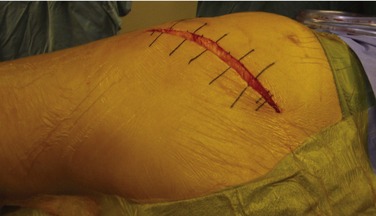CHAPTER 34 Revision Total Hip Replacement
Posterior Approach
KEY POINTS
 The posterior approach provides access to the superior rim of the acetabulum, the posterior column, contained defects within the acetabulum, and the entire femur.
The posterior approach provides access to the superior rim of the acetabulum, the posterior column, contained defects within the acetabulum, and the entire femur. The sciatic nerve and the superior gluteal nerve are the key structures at risk with the posterior approach.
The sciatic nerve and the superior gluteal nerve are the key structures at risk with the posterior approach. A methodical release of soft-tissue attachments around the proximal femur allows mobilization and circumferential visualization.
A methodical release of soft-tissue attachments around the proximal femur allows mobilization and circumferential visualization.TECHNIQUE
Planning the skin incision entails the use of surface landmarks such as the PSIS, the sciatic notch, the tip of the greater trochanter, and the femoral shaft. The incision will be centered over the greater trochanter, with the proximal limb extending toward the PSIS, and the distal limb paralleling the femoral shaft (Fig. 34-1). The skin is incised with a knife, and the initial dissection is carried through the subcutaneous fat down to the tensor fascia. The fascia may be exposed by carefully elevating the fat just enough to expose the edges of the fascia for later closure. The fat and skin should be handled with care throughout the surgery to prevent devascularization or injury that could predispose to wound dehiscence or breakdown of the skin closure.
Stay updated, free articles. Join our Telegram channel

Full access? Get Clinical Tree








